Prefabricated steel buildings, also known as prefab steel or prefab metal buildings, are structures that are manufactured offsite using steel framing and sheeting. They are then transported and assembled onsite using bolts and screws. Prefab steel buildings are increasing in popularity due to their many benefits compared to traditional construction methods.

Highlight List
- Durability and Longevity
- Cost Effectiveness
- Design Flexibility and Versatility
- Fast Construction Timelines
- Energy Efficiency
Durability and Longevity
Prefab steel buildings are extremely durable, long-lasting, and can withstand harsh weather conditions. The steel construction is resistant to high winds, earthquakes, hurricanes, tornados, and heavy snow loads. Steel does not burn or rot, so it is not susceptible to fires, insects, or rodents. The metal sheets are coated with compounds like galvalume, an aluminum-zinc alloy coating, that prevent rusting and corrosion. With little required maintenance, prefab steel structures can last 40-50 years or more.
A recent study showed a prefabricated steel residential building in Japan survived a major earthquake in 2011 with minimal damage. The building's lightweight steel structural panels reduced seismic forces while its bolted connections helped control shaking motions. This demonstrated how prefab steel construction can withstand natural disasters.
Cost Effectiveness
Prefab steel buildings are extremely cost-effective compared to conventional construction using materials like wood, concrete and brick. Steel is an affordable building material and prefabricated sections keep labor costs low. Because construction is faster, there are additional cost savings from reduced on-site construction supervision and temporary facilities.
According to the MDPI Journal, prefab steel buildings for residential use can cost 20% to 30% less per square foot than conventional site-built homes. For commercial structures,cost savings of 10% to 20% are typical.
Maintenance costs for prefab steel buildings are also lower over the lifespan of the structure. With steel's durability and resistance, less frequent repairs are needed. The long service life of prefab steel leads to high value and return on investment.
Design Flexibility and Versatility
Prefabricated steel buildings are versatile and offer almost unlimited design flexibility compared to other building systems. The interiors of steel structures are wide open without columns, allowing complete freedom when laying out floor plans. Steel framing can accommodate long clear spans and tall ceilings to create spacious interior environments.
According to the MDPI Journal, Prefab steel buildings can be designed in many shapes like arched, domed, and curved. They can have modular sections or be customized as needed. They are suitable for a wide range of building types from airplane hangars to offices.
Owners can select from different exterior finishes like metal siding, brick, stone, stucco etc. Prefab steel buildings can be modified and expanded easily in the future with minimal disruption.
Fast Construction Timelines
One of the biggest advantages of prefabricated steel buildings is how quickly they can be constructed compared to conventional building methods. Because the structures are pre-engineered and components precut to specifications offsite, onsite construction is simplified and accelerated.
According to the CSE Magazine, steel building systems can reduce project scheduling by 30% to 50%. For a 10,000 square foot commercial building, construction time can be cut from over a year to less than 6 months.
Modular steel buildings are delivered to the site pre-assembled, minimizing complex on-site construction. Foundation work proceeds concurrently with manufacturing. Overall faster project timelines reduce costs significantly.
Energy Efficiency
Prefab steel buildings are designed to be energy efficient, helping to reduce ongoing energy costs. The metal envelope does not allow air infiltration, while steel framing allows more insulation to be added between studs. This enhances the thermal performance of the exterior walls and roof.
According to the MDPI Journal, prefabricated steel buildings can reduce air leakage by up to 50% compared to traditional building enclosures. Highly insulated prefab steel structures have achieved over R-30 wall performance.
The lightweight roof panels also reflect heat and light. Coatings like galvalume finish help reflect solar radiation. Overall, the energy efficiency of Prefab steel buildings can reduce HVAC costs by 20% to 40%.
Conclusion
Prefabricated steel buildings offer many advantages compared to conventional construction methods. The pre-engineered components make for faster and more economical construction while the durability of steel leads to low maintenance costs and a high return on investment. Owners gain design flexibility along with energy efficiency.
With prefab steel construction continuing to gain mainstream acceptance, it is emerging as a top choice for commercial, industrial, institutional and even residential building projects. Steel modular buildings can be customized to suit almost any need while accelerating construction schedules up to 50%. For quality, resilience and value, prefabricated steel buildings are hard to beat.













